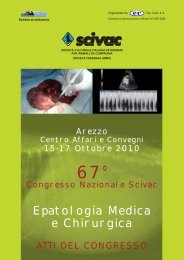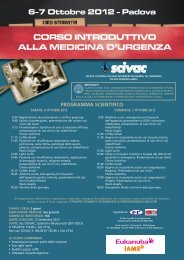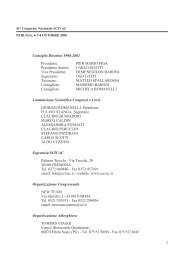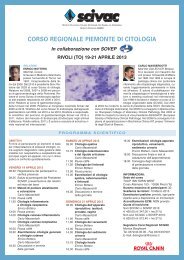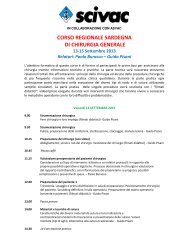58° Congresso Nazionale SCIVAC: Oncologia veterinaria
58° Congresso Nazionale SCIVAC: Oncologia veterinaria
58° Congresso Nazionale SCIVAC: Oncologia veterinaria
You also want an ePaper? Increase the reach of your titles
YUMPU automatically turns print PDFs into web optimized ePapers that Google loves.
58° <strong>Congresso</strong> <strong>Nazionale</strong> <strong>SCIVAC</strong> • Milano, 7-9 Marzo 2008 • <strong>Oncologia</strong> <strong>veterinaria</strong> - Alle soglie del III Millennio<br />
Pharmacokinetics<br />
Lomustine is administered orally. The standard dose used in small animals<br />
ranges from 50 mg/m 2 to 90 mg/m 2 PO on a 3-week basis. Dose for cats has<br />
been reported at 60 mg/m 2 PO or as a 10 mg dose per cat every 3 weeks. Lomustine<br />
is widely distributed because of its lipid solubility. It penetrates the<br />
blood-brain barrier and CSF levels are 15-50% of plasma. Lomustine is extensively<br />
metabolized in the liver to both inactive and active metabolites. The<br />
half-life of the active metabolites ranges from 16 hours to 2 days. Lomustine’s<br />
active and inactive metabolites are excreted primarily in the urine. Prolongation<br />
of plasma concentration is thought to reflect a combination of protein<br />
binding and enterohepatic recirculation of metabolites.<br />
Toxicity<br />
The major toxic effect of lomustine therapy is acute and delayed (4-6 weeks<br />
post dosing) bone marrow suppression (especially thrombocytopenia and leukopenia).<br />
It is recommended that the practitioner monitor the CBC one week after<br />
dosing, and again immediately before the next dose is scheduled. Myelosuppression<br />
can occur for up to 6 weeks after dosing. Nausea and vomiting are rarely<br />
seen with lomustine use. Hepatic toxicity has been described in dogs. While<br />
most of the hepatic toxicity seen was manifested as reversible elevation of liver<br />
enzymes, a small percentage of dogs had progressive, fatal hepatic failure.<br />
Indications<br />
Veterinary indications include the treatment of refractory lymphosarcoma<br />
in dogs and cats, metastatic mast cell disease in dogs and cats, cutaneous<br />
lymphosarcomas, and central nervous system tumors.<br />
Contraindications<br />
Use with caution in dogs treated with drugs that need microsomal enzyme<br />
induction (ie phenobarbital) due to the possible changes in antineoplastic activity.<br />
Combination with other myelosuppressive drugs should be carefully<br />
monitored. Lomustine has been demonstrated to induce significant and even<br />
fatal hepatic toxicity in a limited number of canine patients; its use is therefore<br />
contraindicated in patients with pre-existing clinical hepatic dysfunction.<br />
Use should be discontinued in the face of elevating liver enzyme levels.<br />
61



